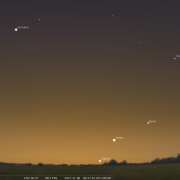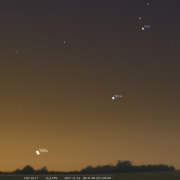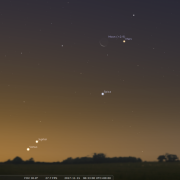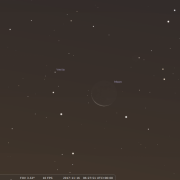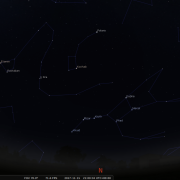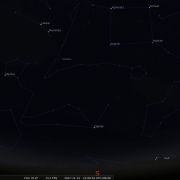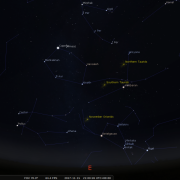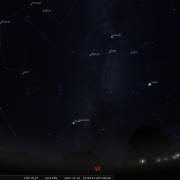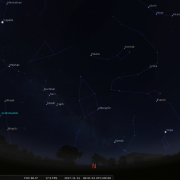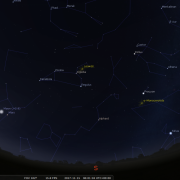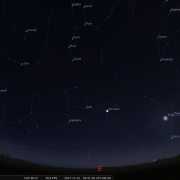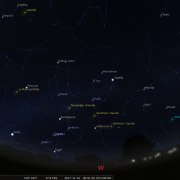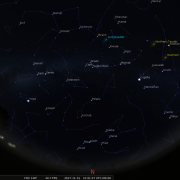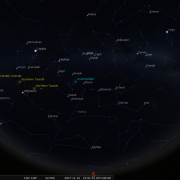In this month's Sky Notes:
Planetary Skylights
Evening

 Although Saturn will be visible until almost the end of the month, through a telescope the view will be rather compromised due to the very low altitude. However before it does depart Saturn has one last hurrah, passing above elusive Mercury, which hugs the horizon for its apparition from the 20th onwards. You will definitely require a clear unobstructed SW horizon to spot them, view approximately 30 minutes after sunset. The 27th may be the best date.
Although Saturn will be visible until almost the end of the month, through a telescope the view will be rather compromised due to the very low altitude. However before it does depart Saturn has one last hurrah, passing above elusive Mercury, which hugs the horizon for its apparition from the 20th onwards. You will definitely require a clear unobstructed SW horizon to spot them, view approximately 30 minutes after sunset. The 27th may be the best date.

 At Magnitude +5.65 Uranus will be visible in a pair of binoculars, however to make out the very small grey/green disk a telescope will be required. The planet can be found in the ESE toward the bottom of the ‘V’ asterism in Pisces, not far above the star Torcularis Septentrionalis. However the best way to locate it will be by using Sheratan and Mesarthim in Aries (the crooked leg of the ram) and sighting down five times the distance between them, and then up one. Hopefully you should spot ‘Herschel’s planet’. The Moon passes through the bottom of the ‘V’ on the 2nd and 3rd – below Uranus.
At Magnitude +5.65 Uranus will be visible in a pair of binoculars, however to make out the very small grey/green disk a telescope will be required. The planet can be found in the ESE toward the bottom of the ‘V’ asterism in Pisces, not far above the star Torcularis Septentrionalis. However the best way to locate it will be by using Sheratan and Mesarthim in Aries (the crooked leg of the ram) and sighting down five times the distance between them, and then up one. Hopefully you should spot ‘Herschel’s planet’. The Moon passes through the bottom of the ‘V’ on the 2nd and 3rd – below Uranus.
 All the action occurs in the early morning sky – with Venus, Mars and then Jupiter all visible. Brilliant Venus is unmistakeable, but is dropping back toward the east horizon, meeting Jupiter emerging into the dawn sky as it does so. On the 13th the two worlds are involved in an extremely close conjunction, when they are separated by just a quarter of a degree! Both will easily fit in the same low power eyepiece of any telescope, so it will be a fantastic sight, but the low altitude and brightening dawn will mean a clear ESE horizon and good timing is required. View around 06:30h. Venus departs the dawn sky before the end of November.
All the action occurs in the early morning sky – with Venus, Mars and then Jupiter all visible. Brilliant Venus is unmistakeable, but is dropping back toward the east horizon, meeting Jupiter emerging into the dawn sky as it does so. On the 13th the two worlds are involved in an extremely close conjunction, when they are separated by just a quarter of a degree! Both will easily fit in the same low power eyepiece of any telescope, so it will be a fantastic sight, but the low altitude and brightening dawn will mean a clear ESE horizon and good timing is required. View around 06:30h. Venus departs the dawn sky before the end of November.
Morning


 All the action occurs in the early morning sky – with Venus, Mars and then Jupiter all visible. Brilliant Venus is unmistakeable, but is dropping back toward the east horizon, meeting Jupiter emerging into the dawn sky as it does so. On the 13th the two worlds are involved in an extremely close conjunction, when they are separated by just a quarter of a degree! Both will easily fit in the same low power eyepiece of any telescope, so it will be a fantastic sight, but the low altitude and brightening dawn will mean a clear ESE horizon and good timing is required. View around 06:30h. Venus departs the dawn sky before the end of November.
All the action occurs in the early morning sky – with Venus, Mars and then Jupiter all visible. Brilliant Venus is unmistakeable, but is dropping back toward the east horizon, meeting Jupiter emerging into the dawn sky as it does so. On the 13th the two worlds are involved in an extremely close conjunction, when they are separated by just a quarter of a degree! Both will easily fit in the same low power eyepiece of any telescope, so it will be a fantastic sight, but the low altitude and brightening dawn will mean a clear ESE horizon and good timing is required. View around 06:30h. Venus departs the dawn sky before the end of November.
Ruddy Mars lies upper right of Jupiter and Venus, below the ‘bowl’ of Virgo. The red planet slowly glides downwards passing above Spica –chief star in Virgo, residing above on the 24th. The waning crescent lies off to the left on the 15th, joining Venus/Jupiter on the 16th and 17th.
 Also on the 16th The Moon lies just 66 arc minutes to lower right of the asteroid Vesta, which at Magnitude 8 should be picked up with binoculars. View around 06:30h. (see chart above)
Also on the 16th The Moon lies just 66 arc minutes to lower right of the asteroid Vesta, which at Magnitude 8 should be picked up with binoculars. View around 06:30h. (see chart above)
Meteors & Comets

The Leonids are active from Nov 15-20th and peak in the afternoon of the 17th, so the evening of the 17th, but more especially the early hours of the 18th will be the optimum time to look. The moon is new so skies will be naturally dark. Observed rates will be normal for a ‘non storm’ year, so expect to view around 7-12 per hour. The next Leonid ‘storm’ is not due until 2030.
Also during November keep an eye out for a few meteors on the night of Nov 4/5th when the South Taurid meteor shower reaches a peak, and then again on the night of Nov 11/12 when the North Taurid meteor shower peaks. The hourly rate is low; - only around 5 meteors, but although few, Taurids can be very bright with occasional fireballs! The Taurids are an old shower, associated with the periodic Comet Enke. Over time dust from this comet has been depleted and spread out over a broad swath of the inner solar system, giving rise to Taurid meteor showers not only on Earth but also on Mars and Venus too!
November 2017 Sky Charts
|
Looking North
Mid-November - 21:00h |
Looking South |
|
Looking East
Mid-November - 21:00h |
Looking West
Mid-November - 21:00h |
| Looking North (morning) Mid-November - 06:00h |
Looking South (morning) Mid-November - 06:00h |
| Looking East (morning) Mid-November - 06:00h |
Looking West (morning) Mid-November - 06:00h |
| Northern Aspect Mid-November - 21:00h |
Southern Aspect Mid-November - 21:00h |
Additional Image Credits:
- Planets and Comets where not otherwise mentioned: NASA
- Sky Charts: Stellarium Software
- Log in to post comments

